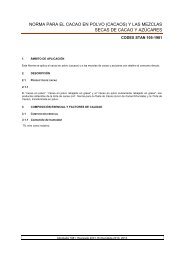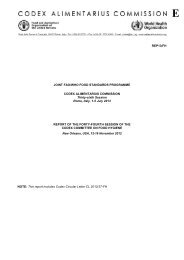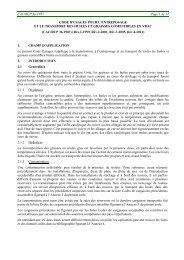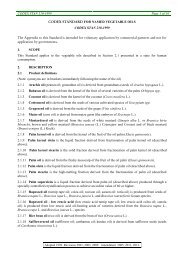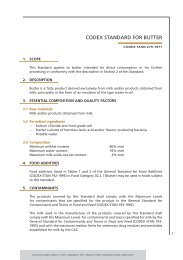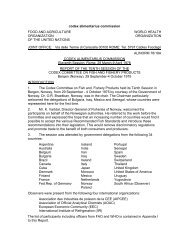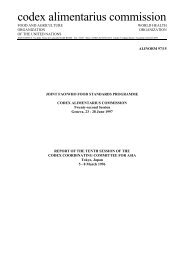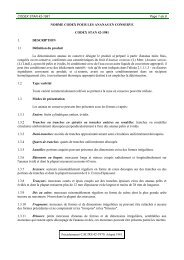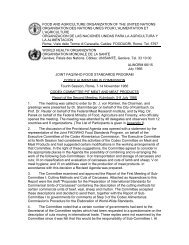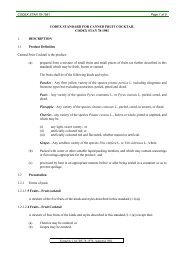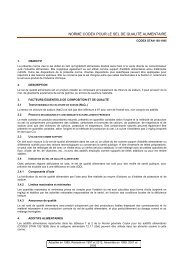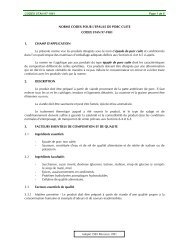codex alimentarius commission FOOD AND AGRICULTURE ...
codex alimentarius commission FOOD AND AGRICULTURE ...
codex alimentarius commission FOOD AND AGRICULTURE ...
You also want an ePaper? Increase the reach of your titles
YUMPU automatically turns print PDFs into web optimized ePapers that Google loves.
ALINORM 81/26<br />
APPENDIX V<br />
PAG - GUIDELINE ON PROTEIN-RICH MIXTURES FOR USE AS SUPPLEMENTARY<br />
<strong>FOOD</strong>S<br />
(PAG - Guideline No. 8 - published 1972)<br />
INTRODUCTION<br />
The serious and widespread problem of malnutrition during the weaning period in<br />
tropical and subtropical countries and the inability of lower income groups to purchase<br />
sufficient animal protein foods or high-cost special children's foods calls for marketing of<br />
nutritious, low-cost mixtures based mainly on vegetable proteins mixed with other<br />
proteins where appropriate. In addition to low cost, satisfactory tolerance and<br />
acceptability on the part of the child and acceptability to the adult(s) responsible for<br />
providing the child's food are important factors. Of paramount importance, however, if<br />
the primary purpose is to be achieved, is the maintenance of minimal nutritional and<br />
sanitary standards, even though this may mean constraints in relation to cost.<br />
Ideally, the protein food mixture should be a supplement which is patterned in<br />
accordance with the child's diet in the home and which fills the gaps with respect to<br />
calories, proteins and other nutrients. In order to be certain that the minimal needs are<br />
covered even under unfavorable dietary conditions, the supplementary food mixture<br />
should provide protein, vitamins and minerals corresponding to recommended<br />
allowances when consumed at the recommended level. The recommended daily intake<br />
of the supplement is usually of the order of 100g dry weight. These products should not<br />
be recommended for infants below six months of age unless they are specifically treated<br />
to ensure complete digestibility.<br />
1. LEVEL OF PROTEIN<br />
The provision of adequate protein generally presents a difficult problem during<br />
the weaning period and special attention should be given to the quality and quantity of<br />
protein in supplementary weaning foods. With protein of nutritional quality equivalent to<br />
cow's milk (NPU = 80); the level of protein in the supplementary food should be at least<br />
15% w/w. If the quality of protein is lower, i.e. NPU less than 80, the quantity of protein<br />
should be increased as follows:<br />
NPU<br />
% Weight/Weight<br />
80 15.0<br />
75 16.0<br />
70 17.1<br />
65 18.5<br />
60 20.0<br />
In any case the NPU value of the protein should not be less than 60 and<br />
preferably nearer 65 and correspondingly the PER not less than 2.1 and preferably<br />
above 2.3 (casein = 2.5; the value for casein varies with different casein products and<br />
the strain of the rat used for testing.<br />
2. CALORIES<br />
The mixture should provide as many calories as possible and this may be<br />
achieved by adding fat. Poorly-digestible carbohydrate, including fiber, should be held to<br />
a practical minimum. The starchy portion of mixtures may be modified through various



